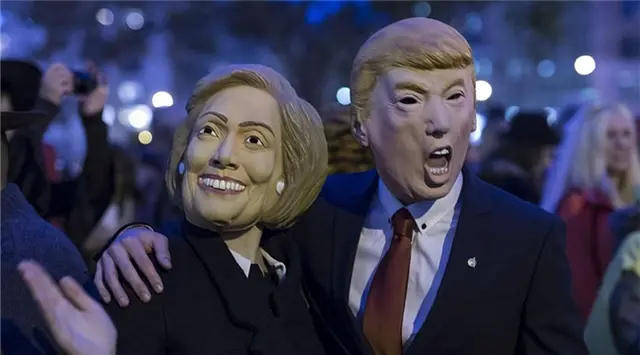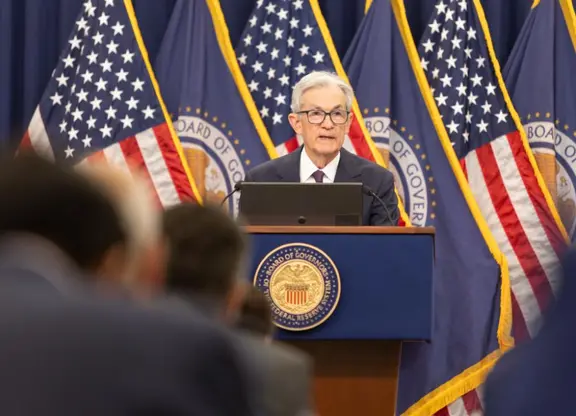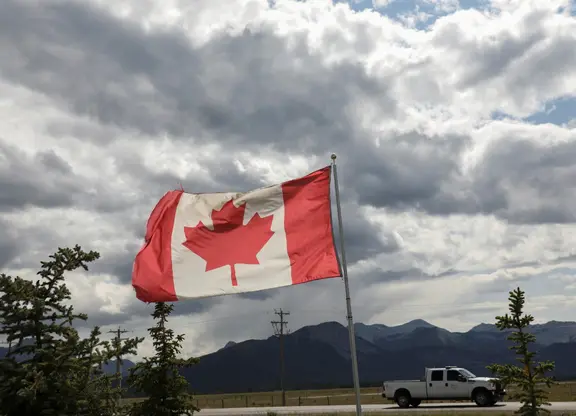The once laughable notion of aHillary Clinton-Donald Trumpmatch-up in November is no longer a joke. The Democratic and Republican front-runners both steamrolled the Northeast on Tuesday night, with Clinton winning at least three primary states, while Trump swept all five.
By 11:00 P.M., Clinton had been declared the victor in Delaware, Maryland, Pennsylvania, and Connecticut, whileBernie Sandersprevailed in Rhode Island. On the Republican side, Trump won each state with about 60 percent or more, securing the vast majority of the 172 delegates up for grabs, and bringing him within 300 delegates of clinching the nomination. “I consider myself the presumptive nominee,” Trump said simply during his victory speech Tuesday night, while Clinton thanked Sanders for “challenging” her during the primary. (As statisticianNate Silvernoted, the Vermont senator must now win nearly two-thirds of the remaining pledged delegates to get a majority, meaning he would need to beat Clinton almost 2-to-1.)
There is still some opportunity for Sanders,Ted Cruz,orJohn Kasichto win their party’s nomination, but their odds keep growing slimmer. Sanders is quickly nearing the point at which winning the Democratic nomination outright becomes mathematically impossible, forcing him to either drop out or mount a divisive, long-shot bid to convince all of Clinton’s super-delegates to change their allegiance at a contested convention. (Their motivation for doing so, should this scenario come to pass, has never been made clear. And Sanders’s campaign has already promised to“reassess”his candidacy after Tuesday night, though he has also vowed to remain in the race.) Cruz has already crossed that threshold, leaving him with no path to the nomination except a brokered convention vote, while Kasich is obstinately hanging on in the hopes ofreenacting the last season of House of Cards. Spoiler alert!
Barring a minor miracle for the G.O.P., a Clinton-Trump cage match appears all-but inevitable, a remarkable and terrifying prospect that, a year ago, would have been truly unfathomable. Millions of first-time voters would surely rush to register for that clash of civilizations, but the battle lines might be drawn in unpredictable ways. Donald Trump, billionaire though he may be, is to the left of Hillary Clinton on trade, and has echoed her calls to raise taxes on the rich. He has repeatedly promised to cater to his blue collar constituents rather than the donor class. His xenophobic, anti-immigrant screeds are popular with a vast number of working class whites across the political spectrum. And despite his disturbingly hair-trigger temper, Trump’s foreign policy instincts still position him as a military dove, compared to Clinton’s impulse toward interventionism. “In a world of Trumpism and Clintonism, Democrats would become the party of globalist-minded elites, both economic and cultural, while Republicans would become the party of the working class,”T.A. Franknoted recentlyforVanity Fair. “Democrats would win backing from those who support expanded trade and immigration, while Republicans would win the support of those who prefer less of both. Erstwhile neocons would go over to Democrats (as they arealready promisingto do), while doves and isolationists would stick with Republicans. Democrats would remain culturally liberal, while Republicans would remain culturally conservative.”
The resulting electoral map is difficult to fathom. One is hard-pressed to imagine Trump winning all of the states that went toMitt Romneyin 2012, plus the additional 64 electoral votes he would need to win the White House. He would have to retake Ohio and Florida, to start, as well as another 20 electoral votes from bluer states. At the same time, Trump’s entire candidacy has been one long surprise to the upside. Recent surveys show Clinton beating Trump in a hypothetical general-election match-up byan average 8.5 points—double the 4-point gap between Obama and Romney, but not so wide a margin that Democrats should rest on their laurels. Clinton has been a prohibitive favorite before, both in 2008 and again this year. Sticking the landing as the front-runner, her aides would surely attest, is not as easy as it seems.
These vintage campaign photos show politics has always been a wild ride
JOHN KERRY AFTER THE DEMOCRATIC NATIONAL CONVENTION AT THE UNIVERSITY OF MASSACHUSETTS BOSTON, ON JULY 29, 2004.
“The Boston Pops were playing along with fireworks and James Taylor was performing onstage. John Edwards’s and Kerry’s handlers were negotiating who’s going to go onstage first. The candidates definitely had their off-stage and onstage personas, and as a photographer I call it ‘getting behind the blue curtain.’”
Photograph by Kenneth Jarecke/Contact Press Images.
KERRY AFTER AN EVENT IN JEFFERSON CITY, MISSOURI, ON AUGUST 5, 2004, DURING A “BELIEVE IN AMERICA” TOUR.
“This was a spontaneous event, it wasn’t supposed to happen. I was in the right place at the right time. After the event there was scheduled filing time, which allows the media to file their work from the day. The band was playing as Kerry was moved from one room to the other, and I guess he just couldn’t help himself, and he just picked up a guitar and started playing. I happened to be the only one there because everybody was filing. That’s who Kerry is; he’s the life of the party, a very social man. I was waiting there for the chance that he would do that.”
Photograph by Kenneth Jarecke/Contact Press Images.
HILLARY CLINTON LEAVING AN EVENT IN CEDAR RAPIDS, IOWA, IN JULY 2007.
“Hillary’s one of the tough ones because she’s got photographers that are longtime, social friends, and so they’re going to get access and people that she doesn’t know aren’t. She’s got a very controlling campaign, so every other photographer was back in the designated area. I wasn’t supposed to be in this area, but she saw me, smiled, and waved to nobody, then quickly shot the look of death to the staffer who let me in.”
Photograph by Kenneth Jarecke/Contact Press Images.
JOHN EDWARDS AT THE IOWA STATE FAIR IN DES MOINES, IOWA, ON AUGUST 16, 2007.
“This was a miserable day. It was over 100 degrees, heavy humidity, so as a photographer you think, What’s my best opportunity to make one picture in any given situation? This is just a handshake picture unless you concentrate on what makes it different: the campaign picture and the pen, media is surrounding him, and he’s got a wireless mike on him. You have to look for your best chance to make a lasting image. There’s always some little aspect you can capitalize on.”
Photograph by Kenneth Jarecke/Contact Press Images.
BARACK OBAMA DURING A DEMOCRATIC DEBATE AT ST. ANSELM COLLEGE IN MANCHESTER, NEW HAMPSHIRE, ON JANUARY 5, 2008.
“This is the main filing center where everybody watches the debate and they all have their laptops out. The new thing at the time was small video cameras. Everyone was shooting videos all the time, which was a new phenomenon, and that took over the campaign in 2008.”
Photograph by Kenneth Jarecke/Contact Press Images.
ON THE STREET WAITING FOR A CANDIDATE TO SHOW UP IN CONCORD, NEW HAMPSHIRE, IN JANUARY 2008.
“This wasn’t Ron Paul’s or Hillary’s campaign headquarters, and that’s Ronald Reagan in the window. This was a spontaneous rally, which happens all the time in New Hampshire. Everybody shows up to everything there. As a photographer, looking at the people that make up the political process is something you can overlook. You’re trying to make pictures of the politician when you turn around and realize there are just as good, or better, pictures behind you. They might not show the actual candidate, but they’re meaningful.”
Photograph by Kenneth Jarecke/Contact Press Images.
BOB DOLE LEAVING AN EVENT IN GREEN BAY, WISCONSIN, IN OCTOBER 1996.
“I love this type of picture where you have the bright spotlights on but it’s still behind the scenes, which speaks to the complex and weird nature of a campaign. You’ve got the Secret Service and the campaign staffers and the rally paraphernalia, and this person who is the reason all this is happening, but they’re also very separate from and isolated by this event that they’re the centerpiece of.”
Photograph by Kenneth Jarecke/Contact Press Images.
JESSE JACKSON AT AN EVENT AT THE BLACK-HISTORY MUSEUM IN GREENVILLE, SOUTH CAROLINA, 1987.
“This is a good one. It’s for aNew York Timesmagazine cover piece on Jackson and I hadn’t done anything behind the scenes with a candidate at that point. I was young, probably around 20 years old, and I got three or four days to travel with him with very close, personal access. The museum was a converted residential home and was packed inside, so I sat outside on the porch as I figured there wasn’t going to be a picture. I heard Jackson start to tear up, pushed my way to the front to see this amazing scene. Not only is he emotional but you’ve also got this statue on the wall so the picture just came together. It made itself.”
Photograph by Kenneth Jarecke/Contact Press Images.
AL GORE, GARY HART, MICHAEL DUKAKIS, AND JACKSON AFTER A DEMOCRATIC DEBATE, BEFORE SUPER TUESDAY IN 1988.
“This was a unique opportunity that’s really hard to get nowadays—a storytelling moment with four different candidates in it. It’s crazy to even think that you could make an image that has this weird visual narrative happening, but that also works as a photo as far as its composition. There’s tension there; there’s a story behind it.”
Photograph by Kenneth Jarecke/Contact Press Images.
DOLE AT AN EVENT IN LOUISIANA, 1996.
“Dole’s campaign had a campaign plane and a ‘zoo’ plane. Traditionally, all the staff and mainstream media ride on the campaign plane with the candidate and the technicians, photographers, and cameramen go on the ‘zoo’ plane, which was more relaxed. The campaign plane broke down so everyone crowded onto the ‘zoo’ plane, and I don’t think there were even enough seats. Back then you could still smoke on planes, so the cabin was filled with blue cigar smoke. Several guys grabbed plates of BBQ so there was also this Cajun feast in the back of the plane and Dole was stuck onboard with everyone. You couldn’t even move from one side to the other it was so crowded. The thing with Dole that people never really realize is the guy has an amazing sense of humor. He’s a very relaxed politician; you never see him nervous and he was always quick with a joke. He was pretty relaxed about the whole situation. Nowadays, they’ve really taken a lot of fun out of the process.”
Photograph by Kenneth Jarecke/Contact Press Images.
BEFORE A PAT ROBERTSON VICTORY PARTY ON SUPER TUESDAY, MARCH 8, 1988, IN ATLANTA, GEORGIA.
“This was one of those weird situations. I saw these boys dressed identically and started to make some pictures and immediately their mother comes in to stage-manage the scene. She was helping to set up the picture and it actually makes a better photograph with her in it. Those hats are probably sitting in an attic somewhere to this day; they’re like trophies. The presidential race is such a unique American experience. It’s a traveling circus.”
Photograph by Kenneth Jarecke/Contact Press Images.
GEORGE W. BUSH LEAVING A PRESS CONFERENCE IN IOWA, IN 2000.
“It’s my philosophy to be in the wrong place, so to be out of place in the hallway where you might not make a picture as opposed to being inside the press conference where you are going to make a picture. In the magazine world you have to make a picture that has some legs and that can last a couple of weeks. If you’re a newspaper or wire photographer you have to have a picture every hour but it’s going to be replaced by the thing you shoot an hour later. It’s a different type of pressure. The reporter in the photograph actually died in the second Gulf War. He was riding with an Air Training Command doing live reports for 30 straight hours and he got a blood clot in his leg from not moving. He was a good reporter. Here, he’s trying to corner Bush and get some kind of answer out of him.”
Photograph by Kenneth Jarecke/Contact Press Images.
A PRO-BUSH RALLY OUTSIDE THE TEXAS CAPITOL IN AUSTIN, TEXAS, IN NOVEMBER 2000.
“This is after the general election that just went on for ever and ever. Bush was still the governor of Texas, so he was going into the office every day, but I think this was a staged event on a Saturday. So I see this picture and I start making this image and I realize this is actually a senior staff member of Bush’s campaign, who I’d only ever seen in a business suit. That was funny.”
Photograph by Kenneth Jarecke/Contact Press Images.
DENNIS KUCINICH SUPPORTERS BEFORE A DEMOCRATIC DEBATE IN DURHAM, NEW HAMPSHIRE, ON DECEMBER 9, 2003.
“The Kucinich people are the most fun and they always have this traveling drum circle. I was trying to make a fun picture as we were waiting for the debate to start. It’s no big deal as an image—what you see is what you get—but it’s interesting from a composition standpoint, and there’s a nice light on there. Kucinich is a nice guy. He’s like Dole—hard to shake and very comfortable in his own skin. I was introduced to him at a rally one night and the funny thing is, often you get behind the blue curtain and it’s all talking and you’re part of the conversation, which is helpful for a writer, but as a photographer it’s very frustrating because you want to be ignored so you can observe and make pictures!”
Photograph by Kenneth Jarecke/Contact Press Images.
GEORGE H.W. BUSH DURING THE GENERAL ELECTION IN OMAHA, NEBRASKA, ON OCTOBER 28, 1988.
“I wasn’t supposed to be on the tarmac here as Bush is vice president and running for president at the time but I knew a press guy on his campaign and I was literally just a kid and he took pity on me. I like this image because it kind of tricks your eye. Because of the flatness of the light and the time of day Bush is almost like this cardboard cutout that someone’s carrying. The composition is nice; the six heads behind him of the Secret Service agents and the priest (who was the president of Boys Town at the time) come together to make a complicated image. And there are little hints, like the banner, and the boom mike, and you can see a couple of American flags, which tell you that this is a campaign event. If Bush’s head wasn’t framed between the guys directly behind him and if his arm was in a different place, the whole composition would be off and the photograph would be wrong to the eye.”
Photograph by Kenneth Jarecke/Contact Press Images.
(VANITY FAIR)
 简体中文
简体中文



